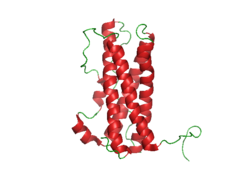Prolactin (PRL), also known as lactotropin and mammotropin, is a protein best known for its role in enabling mammals to produce milk. It is influential in over 300 separate processes in various vertebrates, including humans.[5] Prolactin is secreted from the pituitary gland in response to eating, mating, estrogen treatment, ovulation and nursing. It is secreted heavily in pulses in between these events. Prolactin plays an essential role in metabolism, regulation of the immune system and pancreatic development.[6][7]
Discovered in non-human animals around 1930 by Oscar Riddle[8] and confirmed in humans in 1970 by Henry Friesen,[9] prolactin is a peptide hormone, encoded by the PRL gene.[10]
In mammals, prolactin is associated with milk production; in fish it is thought to be related to the control of water and salt balance. Prolactin also acts in a cytokine-like manner and as an important regulator of the immune system. It has important cell cycle-related functions as a growth-, differentiating- and anti-apoptotic factor. As a growth factor, binding to cytokine-like receptors, it influences hematopoiesis and angiogenesis and is involved in the regulation of blood clotting through several pathways. The hormone acts in endocrine, autocrine, and paracrine manners through the prolactin receptor and numerous cytokine receptors.[5]
Pituitary prolactin secretion is regulated by endocrine neurons in the hypothalamus. The most important of these are the neurosecretory tuberoinfundibulum (TIDA) neurons of the arcuate nucleus that secrete dopamine (a.k.a. Prolactin Inhibitory Hormone) to act on the D2 receptors of lactotrophs, causing inhibition of prolactin secretion. Thyrotropin-releasing hormone has a stimulatory effect on prolactin release, although prolactin is the only anterior pituitary hormone whose principal control is inhibitory.
Several variants and forms are known per species. Many fish have variants prolactin A and prolactin B. Most vertebrates, including humans, also have the closely related somatolactin. In humans, 14, 16, and 22 kDa variants exist.[11]
- ^ a b c GRCh38: Ensembl release 89: ENSG00000172179 – Ensembl, May 2017
- ^ a b c GRCm38: Ensembl release 89: ENSMUSG00000021342 – Ensembl, May 2017
- ^ "Human PubMed Reference:". National Center for Biotechnology Information, U.S. National Library of Medicine.
- ^ "Mouse PubMed Reference:". National Center for Biotechnology Information, U.S. National Library of Medicine.
- ^ a b Bole-Feysot C, Goffin V, Edery M, Binart N, Kelly PA (June 1998). "Prolactin (PRL) and its receptor: actions, signal transduction pathways and phenotypes observed in PRL receptor knockout mice". Endocrine Reviews. 19 (3): 225–68. doi:10.1210/edrv.19.3.0334. PMID 9626554.
- ^ Ben-Jonathan N, Hugo ER, Brandebourg TD, LaPensee CR (April 2006). "Focus on prolactin as a metabolic hormone". Trends in Endocrinology and Metabolism. 17 (3): 110–116. doi:10.1016/j.tem.2006.02.005. PMID 16517173. S2CID 37979194.
- ^ Ali M, Mirza L (1 May 2021). "Morbid Obesity Due to Prolactinoma and Significant Weight Loss After Dopamine Agonist Treatment". AACE Clinical Case Reports. 7 (3): 204–206. doi:10.1016/j.aace.2021.01.004. PMC 8165126. PMID 34095489.
- ^ Bates R, Riddle O (November 1935). "The preparation of prolactin". Journal of Pharmacology and Experimental Therapeutics. 55 (3): 365–371.
- ^ Friesen H, Guyda H, Hardy J (December 1970). "The biosynthesis of human growth hormone and prolactin". The Journal of Clinical Endocrinology and Metabolism. 31 (6): 611–24. doi:10.1210/jcem-31-6-611. PMID 5483096.[permanent dead link]
- ^ Evans AM, Petersen JW, Sekhon GS, DeMars R (May 1989). "Mapping of prolactin and tumor necrosis factor-beta genes on human chromosome 6p using lymphoblastoid cell deletion mutants". Somatic Cell and Molecular Genetics. 15 (3): 203–13. doi:10.1007/BF01534871. PMID 2567059. S2CID 36302971.
- ^ Mizutani K, Takai Y (1 January 2018), "Prolactin", Reference Module in Biomedical Sciences, Elsevier, doi:10.1016/b978-0-12-801238-3.98018-8, ISBN 978-0-12-801238-3, retrieved 10 January 2024




